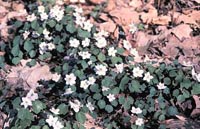Resource Library
Plant of the Week: Rue Anemone
The University of Arkansas System Division of Agriculture does not promote, support or recommend plants featured in "Plant of the Week." Please consult your local Extension office for plants suitable for your region.
Plant of the Week
Rue Anemone
Latin: Anemonella thalictroides

As spring finally floods over the Ozarks like a gradual awakening from a good night’s sleep, we again become acquainted with the delicate flora of the region.
One of my favorites of these early spring bloomers is the delicate-appearing rue anemone, common in woodlands throughout the state. Though less than a foot tall, its white or light pink flowers make an effective display against the brown leaf litter during March and April.
These delicate plants grow about 9 inches tall from pencil-like tuberous roots and form small colonies. The compound leaves arise from the root system on thin wiry petioles and are a light, glaucous gray, double or triply divided with the leaflets about the size of a dime with three terminal notches. The leaves have a somewhat rue-like in appearance but much more delicate than the rue of the herb garden.
The white or delicate pink flowers are about the size of a quarter and have from five to nine petal-like sepals that surround a pincushion of yellow-green stamens. Because the showy parts of the flowers are sepals and not true petals, individual blossoms remain attractive for three weeks or longer, making them one of the longest blooming plants of the spring flora. Plants continue to bloom for about two months.
Double-flowered white and pink forms are available from specialist growers and look like miniature tuberous begonias.
Rue anemone, the only member of this genus, is a member of the Ranunculus family. It’s widely distributed in the Eastern deciduous forest from East Texas to Minnesota and all points east. It usually appears on sloping ground or forest benches on north or east facing slopes.
Learning to identify wild flowers, especially on the curvy roads of the Ozarks at 60 miles per hour, was one the first chores I undertook upon arrival in the state. I soon learned that pepper root and rue anemone are two native wild flowers that are common throughout the Ozarks and bloom in the early spring.
Occasionally, on seeing a white flash out of the corner of my eye that didn’t look like either pepper root or rue anemone, I would slam on the brakes and head for the nearest precarious parking spot. All too often, after trudging back to the spot, these unidentified white "flowers" turned out to be chicken feathers blown from a passing Tyson truck that had stuck in bush.
Growing rue anemone in the shade garden is easy. Because the plants are small, cluster several together in clumps to form an effective display. They need reasonably well drained soil but will tolerate some fairly heavy clays so long as it is on a slope.
Propagation is by division of the roots which can be done as soon as the plants finish flowering. Once the clump is established, division is not usually required to keep these springtime beauties blooming. Rue anemone are attuned to dry summers under the canopy of towering oaks, so despite their delicate appearance, babying is not necessary.
By: Gerald Klingaman, retired
Extension Horticulturist - Ornamentals
Extension News - April 6, 2001
The University of Arkansas System Division of Agriculture does not maintain lists of retail outlets where these plants can be purchased. Please check your local nursery or other retail outlets to ask about the availability of these plants for your growing area.